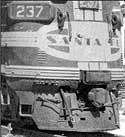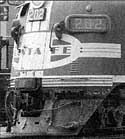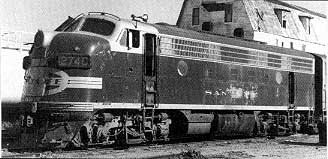MODELERS' NOTE BOOKby the Santa Fe Modeler Staff |
|
|
Painting and Lettering All 200-class F-7's except units 269 through 280 were delivered from EMD in the "catwhisker" paint scheme. The creamy yellow paint was specified for use on all units built through February 1951. Units 269 through 280 and the F-9's were delivered in the "cigar band" paint scheme as shown on the styling diagram Refer to the Painting and Lettering discussion for additional painting notes. To correctly paint and letter the latter units, refer to the F-7A and B styling diagrams. All 200-class units carrying the "catwhisker" scheme also received the latter version of the nose emblem. The best date for Santa Fe's change over to the "cigar band" paint scheme is 1952. Santa Fe painting documents list several revisions beginning in 1951, It is possible the solid blue paint with the "cigar band" was, in fact, considered as a replacement for the "catwhisker." One of the major differences in painting a 200-class unit as compared to an FT is the extension of the yellow stripes around the ends of the carbodies. On all F-3's, F-7's and F-9's the yellow stripes at the top and bottom extended for about five inches on the rear end of the A-unit (obviously on both ends of the boosters). This applies to both paint schemes even though it is not clearly apparent on the styling diagram. Stewart's F-3A model is correctly painted in this manner. Ft's did not have the wrap-around stripes due to mechanical differences in the carbody and end. Stainless steel air grilles were unpainted. On units originally delivered by EMD, the ends were painted standard dark blue but on later repaints, the Santa Fe specified the ends to be black (1954). At this time, the roofs of the units were also changed from black to blue. Again, the styling drawings show the changeover from the "catwhisker" to the "cigar band" as being October 1953. Since there had been no deliveries of F-7's since September 1951, it is reasonable to assume the Santa Fe made the change in its own paint shops between those dates. "Santa Fe" lettering on booster units dose not appear in the "catwhisker" paint scheme. This lettering was added in the "cigar band" design. Silver paint above the side cab steps appears to be present on delivery photos. It is reasonable to assume the small 'L' and 'C' designators below the nose herald rarely appeared on locomotives wearing the "catwhisker" paint. In the "cigar band" scheme however, they appeared consistently. Decals for the "cigar band" paint scheme are available from either Champ or Microscale as shown on the styling diagram. -Jay Miller Diaphragms As built, all Santa Fe F-units (both A and B units) were equipped with diaphragms. They were removed from most surviving units in their later years. Construction of model diaphragms is relatively easy with folded paper and a styrene striker plate. Commercially available detail parts from Walthers also work well. Refer to published drawings (or the styling diagrams) for the striker plate design however. Photos of the locomotive you are modeling should be used for reference in order to accurately detail that particular unit at any given point in its career. -Lee Berglund Pilots, MU Doors and other Details Two rather distinctive pilots are present on 200-class units. Both the Athearn and Stewart models are equipped with what have become known as "passenger pilots" identified by a "notch" step on both sides. A "freight pilot" was delivered on all FT units. It differed in that a small step was mounted outboard on each side above the rail and the pilot had no "notch." Some units of the 200-class were equipped with "passenger pilots." Among them was one unit of the 200 set- the other 200 had a freight pilot! Others spotted include 210, 212, 220, 222, 225, 227, 237 and 245. Check photographs for specific units you are modeling! Things tended to change as the years went by. -John Moore |
|
 Passenger Pilot on 237 at Cleburne -1972 |
 Freight Pilot on 202 at Dallas - 1967 |
|
Units above number 207 were delivered with twin seal-beam headlights in the standard headlight housing. Lower numbered units were delivered with a single filament 64-volt lamp. According to Locomotive Folio dated October 1, 1969 the following 200-class locomotives had front MU connections: 200C, 201C, 202LC-204LC,206C, 208LC, 210LC, 211LC,214C, 216LC-218LC, 219C, 220LC, 221LC, 224LC, 226LC 227LC, 229LC-244LC, 245L 246LC-250LC, 254LC, 255LC, 257LC, 259LC, 263LC,268LC-274LC, 275L, 276LC, 278LC and 279LC. -John Moore |
|
| Late Production F-9's | |
 274C shows the left side appearance of late production F-7's 269 through 280 (delivered in this familiar paint scheme). Air piping on the roof and the larger fuel tanks are clearly apparent in this photo at Kiowa, Kansas in September 1975. Fuel tank skirting on this unit is as it was delivered-less than on earlier units because of the larger fuel tank. Note also the 48" D/B fan and vertical slits in carbody. -Lee Berglund |
|







